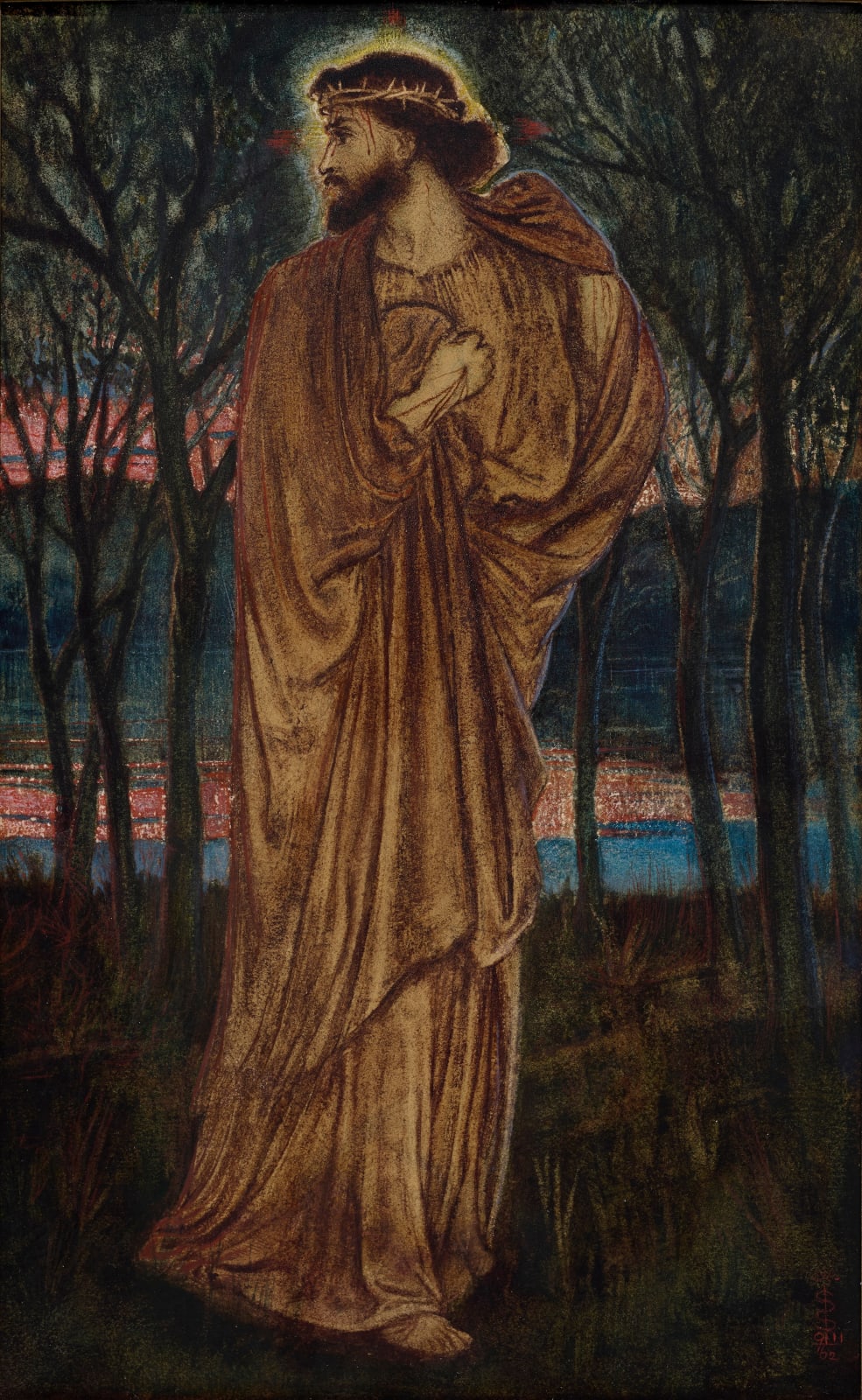Simeon Solomon (1840-1905)
Simeon Solomon, born on October 9, 1840 in London, was the eighth child of Michael Solomon and Catherine Levy. His father, a prosperous merchant dealing in Leghorn hats and among the first Jews to be named a freeman, died when Simeon was a teenager. Despite pervasive anti-Semitic stereotypes, Victorian society slowly became more accepting of Jewish contributions. In 1858, Lionel de Rothschild became the first Jew to take a seat in the House of Commons. That same year, at just 18 years old, Solomon became the youngest artist to exhibit at the Royal Academy.
In his twenties, Solomon became the youngest member of the Pre-Raphaelite Brotherhood, the influential circle of painters and poets formed in 1848 as a reaction against the Royal Academy’s establishment. The last new member to join the Pre-Raphaelites, Edward Burne-Jones described Solomon as “the greatest artist of us all.”[1] Solomon’s work, rich with religious symbolism, resonated with their rationale, though his Jewishness marked him somewhat of an outsider.
1862 proved a pivotal year for the 22-year-old Solomon. That spring, he left his brother Abraham’s studio and established his own at 22 Charles Street, near Middlesex Hospital, loosening ties with the Jewish family traditions. In November 1862, Solomon completed Who is He that Cometh from Edom with Dyed Garments from Bozrah?, a question from Isaiah 63:1. The watercolor marked a dramatic departure from his earlier Talmudic themes, depicting Jesus as the Messiah in a Christian interpretation of the Old Testament passage.
Through Dante Gabriel Rossetti and Edward Burne-Jones, Solomon was introduced to James Leathart, a prominent Pre-Raphaelite patron.[2] After Leathart’s death in 1895, the watercolor was exhibited at Goupil in London before being auctioned at Christie’s.[3] While other works from Leathart’s collection, such as Solomon’s Sappho and Erinna in a Garden at Mytilene, now at the Tate, found prominent homes, Who is he… remained with the Leathart family. It was exhibited only once in the twentieth century, concealing its significance as Solomon’s earliest depiction of Christ.
Aligned with a broader Victorian trend, the Pre-Raphaelites’ embrace of androgynous models resonated with Solomon’s queer identity. The Kabbalistic notion of Adam as a unified male-female creation may have offered spiritual solace in reconciling his own sense of self. Although homosexual identity began to emerge in the 1870s, it remained stigmatized and legally fraught. In the end, Victorian society’s harsh judgement took its toll. After fifteen years of fame, Solomon’s stellar career would end as abruptly as it began.
On February 11, 1873, Solomon was arrested for indecent exposure in a public lavatory and sentenced to six weeks in the Clerkenwell House of Correction, along with a £100 fine and police supervision. This scandal led to his ostracization by the Pre-Raphaelites and the broader art establishment. A subsequent arrest in Paris resulted in a three-month jail sentence. Abandoned by his peers, Solomon faced destitution, battling homelessness and alcoholism. He died of heart failure on August 14, 1905, in the St. Giles parish workhouse.
After his fall from grace, Solomon became drawn to the suffering Christ, drawing parallels between Christ’s ostracism and his own rejection by society.[4] As a pariah, who had alienated his few friends and family, Solomon often sought spiritual consolation in a Carmelite church at Kensington.[5] Conceived at the height of his career, drawn to the allure of Catholicism, its pageantry and rituals resonating with his artistic sensibilities, Who is he… foreshadows Solomon’s long fondness for Jesus, the Jewish born martyr whose life was colored by ostracism and rejection, in spite of his faithfulness.
Please note that this work is the subject of a loan request for an exhibition dedicated to the artist, to be held at the Delaware Art Museum in Wilmington in the spring of 2027.
[1] Alfred Werner, “The Sad Ballad of Simeon Solomon”, The Kenyon Review, Vol. XXII, No. 3, Summer 1960, p. 398
[2] Henry Arthur Sandberg, The androgynous vision of a Victorian outside: the life and work of Simeon Solomon, dissertation, Drew University, Madison, NJ, 2000, p. 112
[3] Ferrari, op.cit. p. 55, fn. 5. Leatheart’s collection was for sale at the Goupil Gallery, where seven drawings by Solomon were exhibited, while the remaining five works were auctioned by Christie’s on 19 June 1897.
[4] Sandberg, op.cit., p. 259
[5] Werner, op.cit., p. 407
Provenance
James Leathart (1820-1895), Bracken Dene, Low Fell, Gateshead
His sale, Christie’s, London, 19 June 1897, lot 16, where acquired by
Boussod, Valladon & Cie., London, on behalf of
Percival Wilson Leathart (1875-1952), Overacres, Alnmouth, United Kingdom, by descent
Margaret Ellen Leathart-Beasly (1888-1974), by descent
Percival Scott Leathart (1919-2002), United Kingdom
Private collection, United Kingdom
Sale, Woolley & Wallis, Wiltshire, United Kingdom, 4 September 2024, lot 770
Exhibitions
London, The Goupil Gallery, A Pre-Raphaelite Collection. D.G. Rossetti, Ford Maddox Brown, Holman Hunt, Burne-Jones, Albert Moore, Simeone Solomon, Inchbold, Etc., Etc., 13 June – 31 July 1896, lot 28
Newcastle upon Tyne, Laing Art Gallery, Leathart Exhibition, 7 October - 16 November 1968, no. 74 (lent by Mrs. Percival Wilson Leatheart, label verso)
Wilmington, Delaware Art Museum, Simeon Solomon, 13 March - 27 June 2027
Literature
Roberto C. Ferrari, “Pre-Raphaelite Patronage: Simeon Solomon’s Letters to James Leathart and Frederick Leyland”, in: Love Revealed: Simeon Solomon and the Pre-Raphaelites, London & New York 2005, p. 55, fn. 5
Carolyn Conroy, “He hath mingled with the Ungodly”: the life of Simeon Solomon after 1873, with a survey of the extant works, Vol. I, dissertation, University of York 2009, p. 238


